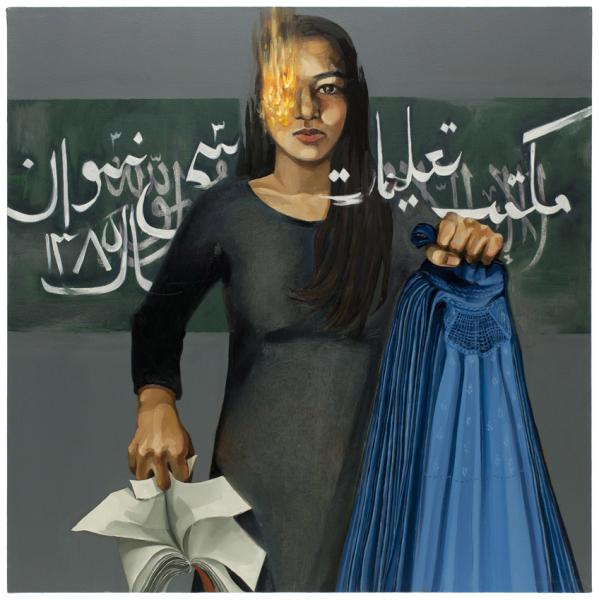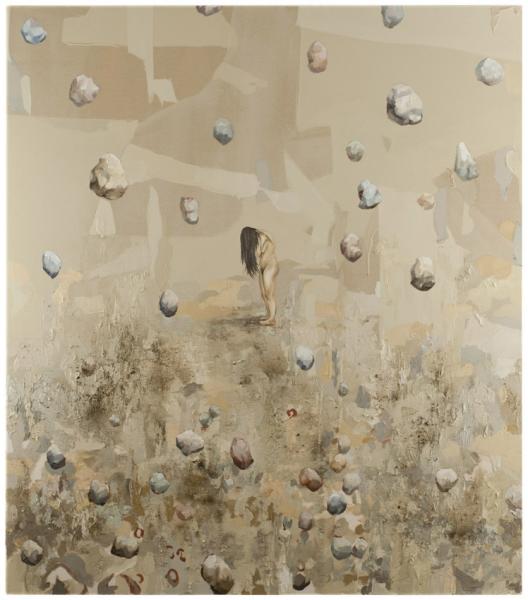Hangama Amiri, one of this year’s cover art contest judges, is an Afghan-Canadian artist. She was a Canadian Fulbright and Post-Graduate Fellow at Yale University School of Art and Sciences and has exhibited her painting nationally as well as internationally in such cities as New York, France, Italy, and London. Room’s Geffen Semach spoke with Amiri to learn a little more about her work and her expectations for the contest.
Hangama Amiri, one of this year’s cover art contest judges, is an Afghan-Canadian artist who grew up in Kabul and moved to Nova Scotia in 2005 where she received her BFA from NSCAD University (Halifax, N.S.) in 2012. She was a Canadian Fulbright and Post-Graduate Fellow at Yale University School of Art and Sciences and has exhibited her painting nationally as well as internationally in such cities as New York, France, Italy, and London (U.K.). Amiri won the 2011 Lieutenant Governor’s Community Voluntarism Award, the 2013 Portia White Protégé Award, and her painting, “Island of Dreams”, won an honorable mention at the RBC Canadian Painting Competition in 2015.
Room’s Geffen Semach spoke with Amiri to learn a little more about her work and her expectations for the Cover Art Contest.
Geffen Semach (GS): In an interview with CBC you mentioned that when you left Afghanistan, one particular issue that struck you was the banning of women from the education system–particularly the effect of this suppression on your mother. You have also collaborated with your sister, Fazila Amiri, on various projects. Can you elaborate on the relevance of your shared experiences with family and how they have informed your art in respect to women?
Hangama Amiri (HA): Yes, indeed. My family has greatly acknowledged my art and particularly they resonate with the subject of feminism in my paintings. Whenever I show my paintings and my collaborative video projects to my parents, intellectually they engage in the dialogue because the work speaks to them on an emotional, social, and political level.
In a way, representation of women against the backdrop of Afghan landscapes creates nostalgia for my mother, and through her comments I understand that my work speaks to all Afghan women who share common stories during decades of war.

My Motherland #1 by Hangama Amiri 2015, video art
GS: You have noted that topics of “women’s representation of bodies and gender and politics and religion” inform your work greatly. Regarding experiences, what role does implication or responsibility play in art to you?
HA: My work is solely a reflection of my personal experiences and my cultural awareness of Afghanistan and Afghan culture. I do feel responsible to create post-feminist and modern artworks to open up a cross-cultural dialogue to expand views on what can be contemporary Afghan feminism. I look forward to creating more bodies of work and to having exhibitions in Kabul.
The Wind-Up Dolls of Kabul #2 by Hangama Amiri 2011; oil, acrylic and earth on canvas 4′ x 3.5′
GS: Your work has a very strong voice and theme. What do you consider to be your own dialogue that functions within your work?
HA: I like to paint individual experiences of Afghan women in a contemporary context. I also love screen-printing Dari texts over canvas to imply a cultural statement. I also love the fact that every time I visit Afghanistan, I bring a full fist of Afghan soil to my studio in Canada, and mix it with oil paint to give texture to Afghan landscapes on canvas. I hope I continue with this artistic process using text and soil over figures to add a personal touch and create a sense of belonging and memory.
GS: You have received a Fulbright Canada grant, been the recipient of the Lieutenant Governor’s Community Voluntarism Award, as well as the Portia White Protégé Award. How important are awards and grants for artists?
HA: As an artist, I think receiving awards and grants are for our continuous dedication to making art and working hard within our communities as well. It is about making connections with the public, sharing experiences, opening exhibitions, giving artist talks, and basically building a community for and with them. It really is a great honor to be represented in such prestigious and competitive platforms because I have gained not only the press/media recognition, but also it has given me more opportunity to get my work presented in national and international art galleries and shows.
GS: Do you have any advice for emerging artists?
HA: I would say keep being open to new challenges in life and continue to practice and express yourself using any medium and technology. Being independent, being critical of your own work, is the key to progress. Most importantly engage and attend the artist talks and their exhibitions in your city to keep being inspired.
GS: Your work is rather political–it critiques and question notions of women and their roles and bodies in different countries and religions. What are some things that get you excited about other artists’ artwork?
HA: I often look and get inspiration from contemporary female artists such as Jamelie Hassan, Shirin Neshat, and Mickalene Thomas. Their art practices also explore female identity, gender, and geopolitics of the places they come from, while finding new ways of mapping cultural experiences through their personal memories.

The Wind-Up Dolls of Kabul #3 by Hangama Amiri 2011; oil on canvas 3′ x 3′
Recently, I visited Mickalene Thomas’s exhibition Repossession at the Lehman Maupin Gallery in New York. I was struck by her use of mix-media trans-media video arts. Her work speaks to me on an intellectual level.
GS: We are so excited to have you judging our cover art contest at Room. What do you look for in Cover Art?
HA: I am very excited to be part of this annual jury art contest. I don’t like to lock up my imagination for certain imagery and expectations, but rather I would like to be open to see the emerging feminist artists’ works and their ideas. I am very much looking forward to being surprised.















